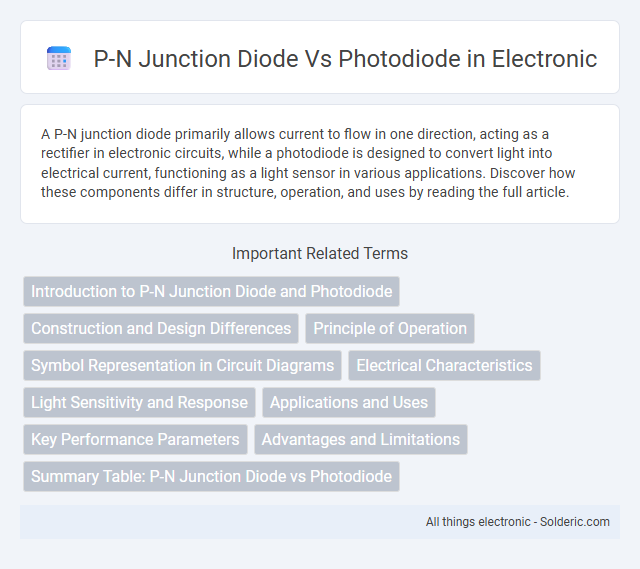A P-N junction diode primarily allows current to flow in one direction, acting as a rectifier in electronic circuits, while a photodiode is designed to convert light into electrical current, functioning as a light sensor in various applications. Discover how these components differ in structure, operation, and uses by reading the full article.
Comparison Table
| Feature | P-N Junction Diode | Photodiode |
|---|---|---|
| Primary Function | Allows current flow in one direction (rectification) | Converts light into electrical current (photo-detection) |
| Operation Principle | Forward-bias conduction, reverse-bias blocking | Photoelectric effect generates current under light exposure |
| Material | Silicon or Germanium semiconductor | Silicon semiconductor with light-sensitive junction |
| Response to Light | No significant response | Generates current proportional to light intensity |
| Typical Uses | Rectifiers, clippers, voltage regulation | Optical communication, light sensors, safety devices |
| Biasing | Forward or reverse bias for normal operation | Usually reverse biased for optimum photo-sensitivity |
| Speed | Fast switching in electronic circuits | High-speed light detection, often nanosecond range |
Introduction to P-N Junction Diode and Photodiode
A P-N junction diode is a semiconductor device formed by joining P-type and N-type materials, allowing current to flow primarily in one direction, used for rectification and switching applications. A photodiode operates similarly but is designed to generate current when exposed to light, converting photons into electrical signals for use in optical communication and light sensing. Both devices rely on the P-N junction concept, with photodiodes optimized for light detection through junction area and material sensitivity.
Construction and Design Differences
A P-N junction diode consists of a simple junction between p-type and n-type semiconductor materials designed primarily for rectification and switching, featuring a uniform doping concentration across the junction. A photodiode, while also based on a P-N junction, incorporates a specialized design with a thin, lightly doped depletion region that enhances light absorption for efficient photoconversion. Your choice between these devices depends on whether you need a basic electronic switch or a sensitive light-detecting sensor.
Principle of Operation
A P-N junction diode operates by allowing current to flow primarily in one direction due to the depletion region formed at the junction between p-type and n-type semiconductors. A photodiode, while based on the P-N junction principle, generates current when exposed to light, as photons create electron-hole pairs that increase conductivity. Your choice depends on whether you need a simple rectifying diode or a device that converts light into electrical signals.
Symbol Representation in Circuit Diagrams
The P-N junction diode symbol in circuit diagrams consists of a triangle pointing towards a vertical line, representing the anode and cathode respectively. The photodiode symbol includes the basic P-N junction diode symbol with two arrows directed towards the diode, indicating light incidence. This distinction in symbols emphasizes the photodiode's function of converting light into electrical current, unlike the standard diode that primarily controls current flow direction.
Electrical Characteristics
A P-N junction diode exhibits typical forward voltage drops around 0.7V for silicon, with a unidirectional current flow and fast switching speeds, mainly used for rectification, while a photodiode operates by converting light into current with a high sensitivity and low dark current under reverse bias. Photodiodes have faster response times and lower capacitance compared to standard P-N diodes, optimizing them for optical signal detection and communication applications. Your choice depends on required electrical parameters like current sensitivity, response speed, and operating voltage in circuits.
Light Sensitivity and Response
P-N junction diodes exhibit low light sensitivity, primarily functioning as rectifiers with minimal response to illumination. Photodiodes are specifically engineered for high light sensitivity, converting incident photons into electrical current with rapid response times ideal for optical sensing applications. Your choice between the two depends on whether light detection and signal conversion are critical for your device's performance.
Applications and Uses
P-N junction diodes primarily serve as rectifiers in power conversion, signal demodulation, and voltage regulation across electronic circuits. Photodiodes are specialized for light detection, widely applied in optical communication systems, solar cells, and medical devices for precise light measurement. The photodiode's sensitivity to light enables its use in safety sensors, barcode readers, and environmental monitoring, contrasting with the general-purpose electronic switching and protection roles of P-N junction diodes.
Key Performance Parameters
P-N junction diodes primarily focus on forward voltage drop and reverse leakage current as key performance parameters, ensuring efficient rectification and minimal power loss. Photodiodes prioritize responsivity, quantum efficiency, and dark current to accurately convert light into electrical signals with high sensitivity and low noise. Understanding these parameters helps you select a diode tailored for either electrical switching or optical sensing applications.
Advantages and Limitations
A P-N junction diode offers low cost and simple design with fast switching speeds, making it ideal for rectification and signal modulation, but it lacks sensitivity to light. Photodiodes are highly sensitive to light, enabling accurate photodetection and optical communication applications, though they exhibit slower response times and require biasing for optimal performance. The P-N junction diode excels in electronic circuit roles, whereas photodiodes are specialized for converting light into electrical signals with high precision.
Summary Table: P-N Junction Diode vs Photodiode
P-N junction diodes primarily function as rectifiers, allowing current flow in one direction with characteristics like forward voltage drop around 0.7V for silicon, while photodiodes operate based on light absorption, converting photons into electrical current with notable responsivity and speed. The P-N junction diode typically exhibits low reverse leakage current and is used in power regulation and signal demodulation, whereas photodiodes show higher sensitivity to light intensity, response times under nanoseconds, and are employed in optical communication and light sensing. Key parameters distinguishing these devices include wavelength sensitivity, with photodiodes designed for specific spectral ranges, and operational bias conditions, as photodiodes often operate under reverse bias to enhance response speed and sensitivity.
P-N junction diode vs photodiode Infographic

 solderic.com
solderic.com